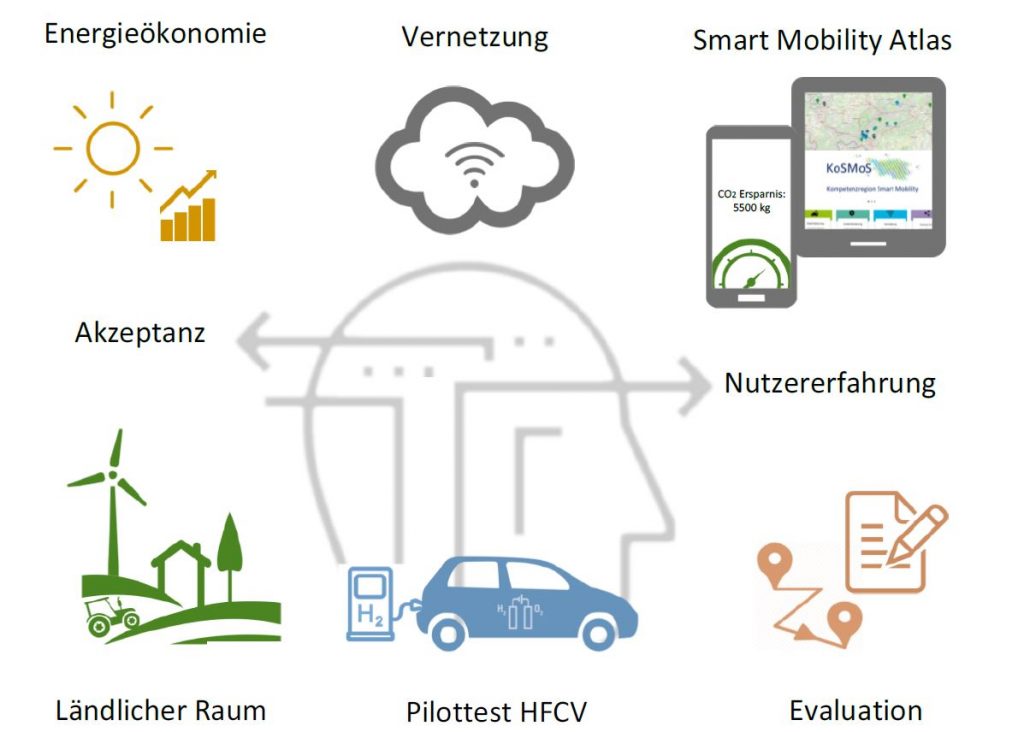EM:POWER (2019-2021)
EM:POWER is a basic and application-oriented pilot project for the everyday use of a hydrogen-based electric vehicle in rural areas. The subjects of the field test are acceptance factors and real-time driving profile data of e-vehicles for data fusion with user experiences and for visualization of CO2 savings in the Smart Mobility Atlas.
Objectives and methods
Current developments in the research environment of Smart Mobility have the potential to fundamentally transform society and the economy. In particular, the electrification of the powertrain offers great potential, but has so far been accepted mainly in urban areas, whereas rural areas are no longer the focus of discussion. The advent of smart mobility could change this.
Against this background, the EM:POWER research project aims at joint, integrative research approaches of economic, environmental and technical sciences. A systemic field test and interdisciplinary cooperation will open up a highly relevant and topical field of scientific and social interest. New perspectives and approaches to solutions are gained through the corresponding changes in perspective. A major challenge and at the same time a special opportunity for the participating disciplines lies in the closely interlinked answering of the questions of basic and applied research and in the necessary expansion of the respective spectrum of methods.
The EM:POWER research project focuses on the testing of concrete mobility applications with hydrogen-powered vehicles. The approach by means of a broad-based field test ensures on the one hand that innovative and sustainable mobility is made known and familiar to the general public, and on the other hand that a concept can be developed on this basis to make a practical contribution to the diffusion and establishment of electric mobility in the sense of sustainability and climate protection. In order to change the behaviour patterns learned in recent decades with regard to the individual use of one’s own car with a combustion engine, intensive communication and a wide range of test offers are required. Electromobility can be a lever here to set the changeover in motion. It also makes it possible to combine regional production with the use of renewable energies. This should make it possible to maintain local added value while protecting the climate.
Project content
By means of the current usage and movement profiles of the rural population, which are to be recorded, it is to be investigated to what extent electrically driven vehicles can be used as an alternative to the conventionally driven passenger car in everyday life. HFCVs appear suitable due to their long ranges. In the future, they will help to minimize emissions and resource consumption and to ensure social participation and free development of the individual without threatening the social welfare and competitiveness of the business location.
EM:POWER will test the practical feasibility of the hydrogen-powered vehicle in everyday traffic. To this end, a pilot project is being launched in the rural areas of the Saarland. An HFCV (plug-in fuel cell vehicle) will be made available to an interested group of addressees for a selected period of time and a traffic and economic evaluation will be carried out on the basis of the field test. The actual use of the vehicles and related experiences will be recorded and evaluated by means of accompanying surveys. One focus is above all on the concrete user or user acceptance. This will be collected during the field test. Thus it will be possible to derive findings on the use of the individual means of transport, especially of vehicles in individual transport in rural areas. The results of the user surveys will be processed and continuously fed back into the field test, so that adjustments in the operational design will be possible. In addition to the user-centred analyses, a test of the perception and model effect of the project in the public is carried out. For this purpose, a live tracking and an online CO2 savings calculator (in accordance with §23 saarl. Data Protection Act) will be integrated into the existing Smart Mobility Atlas to increase visibility and transparency.

Figure 1 – Structure and content of the EM:POWER project (own presentation according to CCO License and OWF, 2019)
The starting point for project development will be an information event. The aim of this is to present the project on site and to acquire test households to manage the first project phase.
For the start and acclimatisation phase 30 test households (quota sample) will be recruited. Each household will receive a fuel cell plug-in hybrid for exclusive use for two weeks free of charge from January 2021. Refuelling took place at the first hydrogen filling station in Burbach in Saarland. This phase served the test persons to get used to the technology and handling of the electric vehicles. The free use of the electric cars is combined with a strong involvement in the research activities, with surveys before, during and after use and in the form of a final interview. At the end of the first phase, all surveys and interviews conducted will be evaluated and discussed with the test persons in a workshop. The actually collected driving data will be compared with the specified driving profiles and an energy-economic evaluation will be carried out.
Electric mobility as a new technology leads to new challenges or requires a new approach. The project therefore plans a pilot project with this vehicle, in which it will be tested for current usability and, if necessary, new approaches for the use of e-vehicles will be developed. For this purpose, the vehicle costs and the usability of e-vehicles must compete with existing conventional vehicles. The field test will demonstrate the usability of electric mobility in rural areas and present it to the public. The results will be published regionally and nationwide and presented at a final event to serve as a best practice example for other regions in Germany.
Project duration
01.10.2019 to 30.09.2021
sponsored by:

